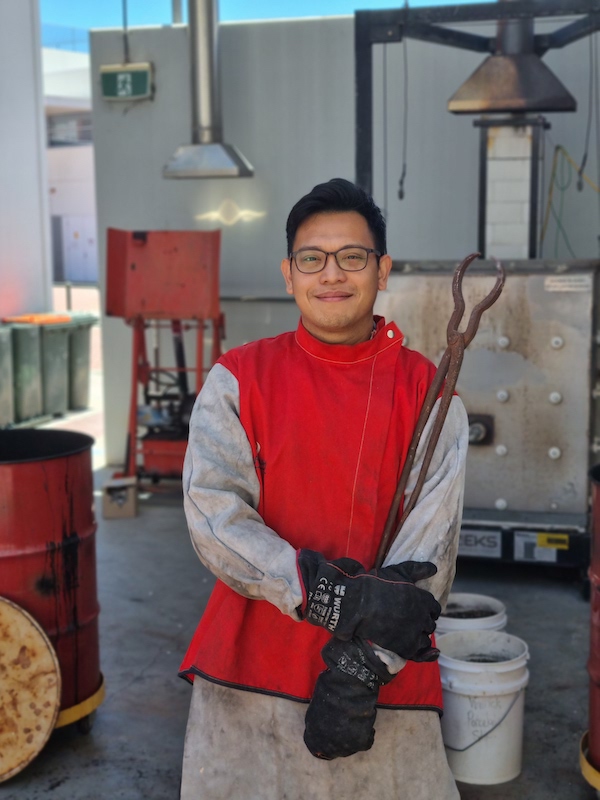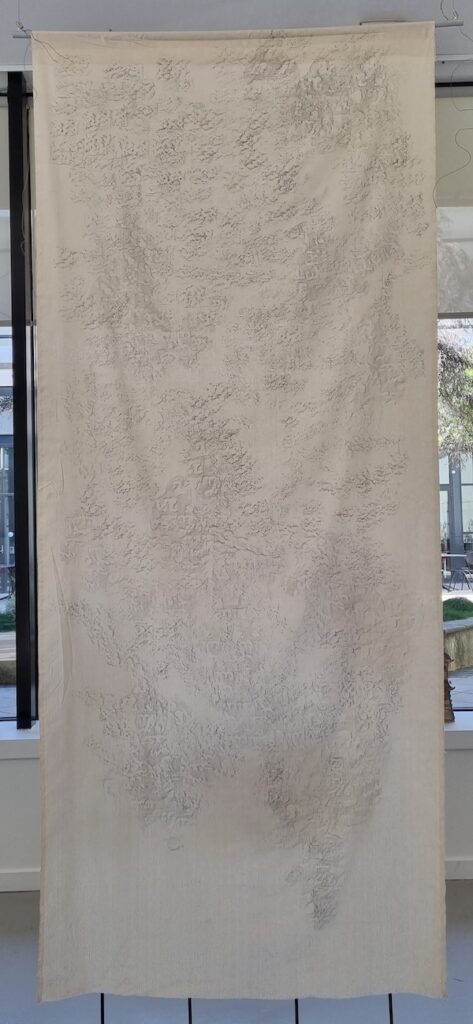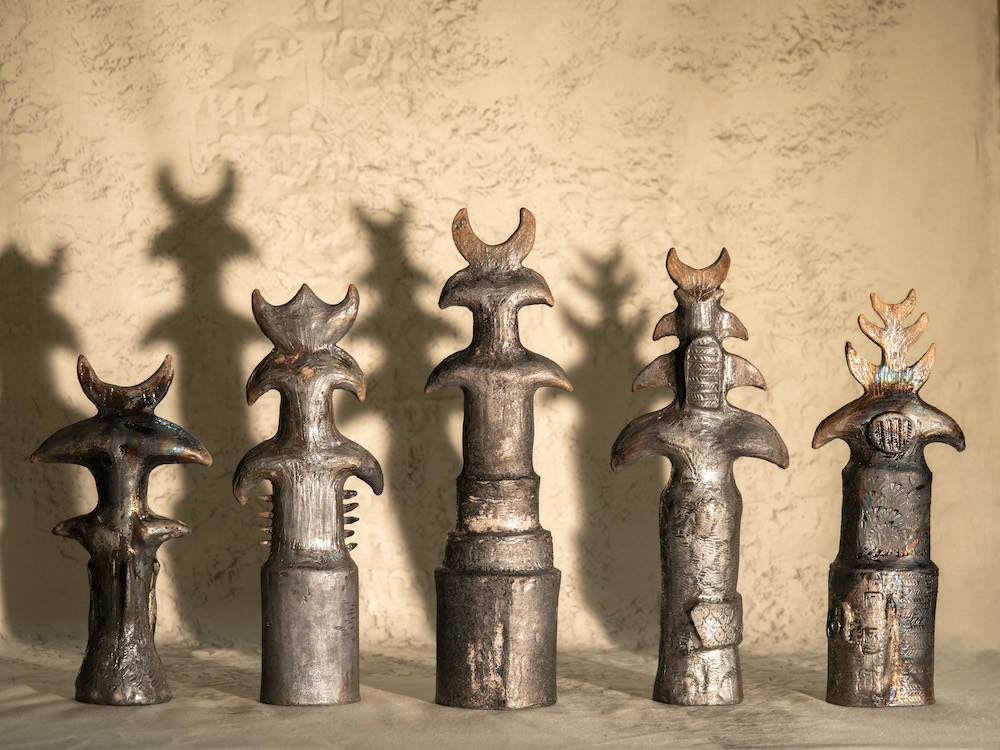Artist Nazerul Ben-Dzulkefli may be a recent graduate but he’s already making a name for himself at Perth’s independent galleries, with ceramic works that draw on the rich tapestry of his Malay-Javanese upbringing in Singapore’s cultural melting pot.
Calling on spirits, demi-gods and unseen beings
11 May 2022
A graduate of North-Metropolitan TAFE, Singapore-born and raised ceramic artist Nazerul Ben-Dzulkefli has exhibited at local galleries such as the State Library of Western Australia, Gallery Central, Spectrum Project Space, Edith Cowan University, and the former Turner Galleries. His work was most recently seen at Stala Contemporary as part of “New Moves”.
Inspired by the folk beliefs of Singapore’s multi-ethnic culture, Ben-Dzulkefli explores the possibility of communing with unseen gods and spirits in his practice. He is interested in the connection between spirituality and care of the environment, and hopes to promote conversation around this topic.
Ben-Dzulkefli is one of 25 artists selected from around Australia to exhibit work in PICA’s 2022 Hatched National Graduate Survey, which celebrates the work of leading emerging artists who have recently graduated from tertiary study.
Ahead of the opening of “Hatched” Nina Levy caught up with Ben-Dzulkefli to find out more about what drives his work.
Nina Levy: Nazurel, when did your interest in making art begin? At what point did you know that you wanted to pursue art as a profession?

Nazerul Ben-Dzulkefli: My interest in art making started early during my formative years. I lived in a home that encouraged creative pursuits in a multicultural estate in Singapore where my maternal grandfather’s melodic recitation of the Quran and the occasional Chinese funeral music from a nearby communal space became somewhat of a soundtrack of my early days.
My parents have always encouraged me to dabble in the arts and even offered to sponsor my tertiary arts education in Singapore’s Lasalle College of the Arts – an offer my younger self declined in favour of a more mainstream STEM pathway. After seven years of working in the education industry, I reassessed my life’s priorities and dove right into the art world as an art student starting from scratch, in a new city – Perth.
NL: Why Perth?
NBD: During my first visit to Perth in June of 2011, I was captivated by the scent emanating from the gum trees, the wide-open spaces and of course the beautiful blue skies. I returned to Western Australia the year after and explored Coolgardie where a friend of mine was working as a teacher and a school bus driver. We stayed in his little cabin in the middle of winter, that night, I saw more stars than I had ever seen with my naked eyes. I was hooked. The light pollution in Singapore robbed us off the celestial bodies; here in Perth, I still get to enjoy them at night when I step out into my backyard.
NL: What is it about ceramics that appeals to you?
NBD: Working with clay leaves a lot of room for improvisation and spontaneity. The act of transforming simple base material, such as earth, into objects that can be imbued with rich narratives and power is an exceptionally magical experience.
NL: How has your upbringing in Singapore influenced the kind of work you make?

NBD: Growing up in a Malay-Javanese household in multi-ethnic Singapore has allowed me to experience the different sights and sounds, cosmologies, beliefs and practices of the cultures around me.
My work, since I arrived in Perth, taps off the richness of the cultures, visual language and shared mythologies of Singapore and the larger Malay Archipelago. Issues surrounding religion, culture, death and dying are often punctuated by my relationship with the land and water bodies and how we share the tiny island with the unseen.
NL: You talk about starting, “a conversation about religious exclusivity and care of the environment through guidance and collaboration with local gods and ancestral spirits.” Given the urgency of the climate crisis, this feels highly relevant. Can you tell me more?
NBD: My Muslim upbringing has taught me that we are stewards of the planet as opposed to its owners. That, coupled with my animist pre-Islamic Malay beliefs, reinforced a view cosmos where I am part of a symbiotic ecosystem which includes nature spirits, demi-gods and other unseen beings, with whom I share the natural environment.
Through my art making process, I often think about ways to remind myself and those around me of the importance of consuming only what we need lest the trees, animals and spirits are left with nothing due to our negligence and avarice.
This syncretic worldview is shunned by the Muslim (especially after the 1970s Islamic revival in the region) and Christian communities in Singapore. It is perceived as superstitious and a strictly orthodox worldview is preferred.
NL: Is that shunning what you’re referring to when you talk about “religious exclusivity”?
NBD: Yes. I want to highlight the normalcy of religious and spiritual syncretism in Singapore amongst the Malay Muslims prior to the Islamic revival of the 1970s in the Malay Archipelago which led to the rise of a stricter expression of Islam in the region.
Syncretism of beliefs leaves room for the local communities to perceive the world with a more nuanced lens, allowing for varying and often competing cosmologies to exist in the same space. Pre-Islamic Malay mythologies consider the existence of demigods, nature spirits and other unseen beings with whom we share the natural world. This influences how we treat, care for and benefit from the natural environment, without consuming too much.
Through my work I want people to think about the different ways in which we see and understand the natural world, one that may even be at odds with our cultural or religious upbringing.

NL: Tell me about your work for “Hatched National Graduate Survey 2022” – This Is Where I Hope You’ll Dwell.
NBD: My work for “Hatched” is a culmination of a year-long research and obsession with the pre-Islamic folk Malay practise of creating sacred sites shrines. These sites were believed to be dwelling places of tutelary demigods, departed holy personages, ancestors, malignant and/or benign spirits who share the space with human inhabitants as active collaborators in the continued shaping and stewardship of the land and water bodies. The belief in the unseen is part of the Singaporean identity, albeit lesser known to outsiders given the island nation’s public image as modern cosmopolitan city.
There is a common belief in Malay folklore that spirits are bound by the water bodies that surround their land of origin. Being a migrant who recently settled in Perth, I question the role of the ancestor spirits and demi-gods I left behind in the place of my birth. I am interested in the possibility of a continued connection to the abovementioned unseen actors even as we are separated by the Indian Ocean. Perhaps through acts of remembrance and invocation, they too would be able to traverse the seas.
The anthropomorphic sculptures pay homage to early Malay gravestones and shrines and a way for me to partake in the ancient practice of creating venerating sacred space and invoking the spirits of my ancestors, demi-gods and ghouls from across the sea and from the islands across the Malay Archipelago – a reminder of where I came from and how I am forever connected to the generations of human and non-human beings that came before and may continue to exist after me.
The way the artwork is installed is heavily informed by the aesthetic markers of shrines, offerings and rituals in Singapore reminiscent of Taoist folk altars and Javanese gunungan (mountain-like) offerings.
NL: What’s next for you after Hatched?
NBD: I am currently working as a visual art technician in a school in the northern suburbs, while completing my last few units at North Metropolitan TAFE. Between work and studying, I’m expanding my art practice by churning out more sculptural works in ceramics and networking with contemporary artists in Singapore and WA.
I’m grateful for several collaborations that kicked off this year, including a recent group exhibition “New Moves” at Stala Contemporary featuring a select group of recent visual art graduates, curated by Sherri Staltari. Later in May 2022, I’ll be part of “Oh” at Sweet Pea Arts, a group exhibition curated by Andrew Varano featuring a group of seven extraordinary Perth-based artists.
I’m looking forward to collaborating with galleries and institutions through group exhibitions and public discourses surrounding contemporary and mythological narratives from the Malay Archipelago. I plan to collaborate with artists from various cities in Southeast Asia and Australia, and now that the borders are open, I am no longer bound by the ocean on our doorstep.
“Hatched: National Graduate Show 2022” opens at PICA 14 May and runs until 17 July 2022.
Pictured top: Nazerul Ben-Dzulkefli, ‘This Is Where I Hope You’ll Dwell 2’, 2021, Photo: Criag Williams
Want stories like this?
Check out more Q&As
Like what you're reading? Support Seesaw.






